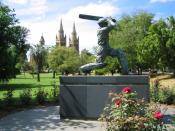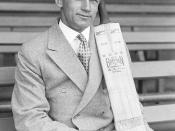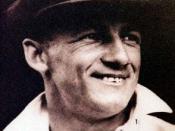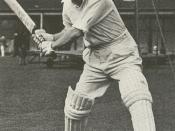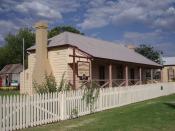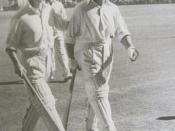The Cricket Dream Came To Life FULL NAME: Donald George Bradman DATE OF BIRTH: 27 August 1908 PLACE OF BIRTH: Cootamundra, NSW DIED: Sunday 25 February 2001 at home in Kensington, South Australia FAMILY: Mother Emily, father George, brother Victor, sisters Islet, Lilian and May - (all older and deceased).
MARRIED: Jessie Menzies in Sydney on 30 April, 1932 (deceased).
CHILDREN: Daughter Shirley, son John KNIGHTED: 15 March 1949 ORDERS: Companion General Division of Order Of Australia (AC), 16 June 1979 HEIGHT: 173cmâ'ìâ'ìâ'ì EYES: Blue OTHER SPORTS PLAYED: Tennis, golf, squash, rugby league (school), Athletics (school) FAVOURITE LEISURE ACTIVITIES: Piano, billiards ACTIVITIES BEST SUBJECT AT SCHOOL: Maths FAVOURITE FOOD: Rice pudding FAVOURITE DRINK: Tea FAVOURITE GROUND: Sydney Cricket Ground GREATEST BOWLER FACED: Bill O'Reilly LAST CRICKET SEASON: Summer of 1948-49 â'ìThe Don Donald Bradman born on the 27 August 1908 in Cootamundra NSW, fifth child of Emily and George Bradman.
Don was the youngest of Bradman children, with brother Victor and sister Iset, Lillian and May. The family lived in the village Yeo Yeo 25 kilometres from Cootamundra. Then two years later moved to a cooler climate as of Don's mothers health. They moved in to a house in Shepherd Street Bowral where Dâ'ìâ'ìâ'ìÃÂéon went to school two years later after moving.
Don was a very active child as he had no friends that lived around his area so he amused himself by playing in the backyard he used to throw a golf ball against a round base of the water tank and then hitting the ball with the cricket stumps. This is not easy when the ball can fly in any direction without knowing it. At the age of nine or ten he managed to hit the golf ball with the stump as he said (during radio interview in 1988) "more often then not". Don was developing his precise co-ordination and skill, which would serve him well in the years ahead as an international cricketer. The truth was that all the practise which he was developing would turn him into a star cricketer.
age 12 first real game for senior school team and his second game on the oval he scored 115 not out from a team total of 150.
still as a teenager he continued to be bâ'ìâ'ìâ'ìÃÂà Âusy with sport.
in February 1921 he begged his father to take him to the Sydney Cricket Ground (SCG) for his father to watch him play his first Test match. The fifthe Test between England and Australia At the SCG, one of a around 30,00 he watched Charlie Macartney making 170 and vowed, Fraser (1997. p.9) wrote "I shall never be happy until I play on this ground" Don later said to his father smiled "with affectionate tolerance".
1925-26 season his mother gave him his first new bat as he made 300 against Moss Vale, aged 17.
1926 - NSW Cricket Association. invited him to attend practise at the SCG.
1927-28 - he was selected to join the NSW team to tour Southern States.
The dream had come to life..
The excitement was just beginning..
Broken Hearts Anthony Davis (1997, p.10) says "He made fools of the English bowlers but the English crowds, with national masochism, did not care; they adorâ'ìâ'ìâ'ì"à ¡ed h im all the more".
A.P.F. Chapman, Captain of England (1997, p.10) "Bradman's Innings was truly magnificent; but confound him just the same".
In the 1930 tour of England, his talent exploded and he broke the hearts of many English teams on many English fields.
In his first English innings, he made 236 (28 fours) against Worcester, then 185 not out in the second against Leicester.
Don was then included in the third Test in Melbourne when he played brilliantly becoming the youngest player to score a Test century with 112 in the second innings.
Scoring a peak of his career in a Sheffield Shield match between NSW and QLD at the SCG in January 1930. He broke the world's batting record for the highest score in first-class cricket, he scored 452 not out in just 415 minutes. He reached this score in just under a run in a minute.
Fraser (1997, p.21) "run making machine" 30th of April 1932 Donald Bradman married Jessie Menzies. They had known each other many years before this.â'ìâ'ìâ'ì"á They moved to Adelaide, SA in 1935 for business reasons.
Don then was elected captain of the SA team and a State Selector.
December 1935 scored 117 first Sheffield Shield match for SA ironically against his former team NSW.
Being the Test selector in 1936 and on 4 december led his country for the first time in the first Test in Brisbane.
Post-war revival Bradman was elected ot the Australian Board of Control in August 1945. He had not played for five years as muscular spasms. However he did accept captaincy in 1946.
1947-48 India came to Australia for the first Test series between the countries played at SCG scored 172 Australia won 4-0 with Bradman's batting average 178.75.
Farewell To Sydney Town The 41,575 crowd gave him one of the most emotional farewells in Australian sport. Bradman scored 53, caught after 65 minutes. He walked off, slowly as usual with a very loud continuous applause. The entire crowd stood in tribute. Twenty-one years of breathtaking, glorious â'ìâ'ìâ'ìÃÂøbatting at an end.
Knighted The 1949 New Year's Honours List included Don Bradman as Knight Bachelor recognising his services to cricket and to Commonwealth sporting links. He was invested as Australia's first cricket knight in March 1949. He became the only Australian cricketer to be knighted.
Career Still Goes On In 1960 he became the first former Test player to be elected chairman of the Australian Board of Control.
On 16 June 1979 he was invested as a Companion of the Order of Australia.
In 1988 he was voted by the Australian Confederation of Sport as the greatest male athlete of the past two hundred years.
In a cricketing career spanning 21 years of first class cricket he averaged a century once in every three innings played. His batting averages have become legendary: in the England tour of 1930 he made 2960 runs (98.66) including ten centuries. On the final tour in 1948, 18 years later he made 2428 runs with an amazing 89.92 average, including eleven centuries.
In recent years, Sir Donald hasâ'ìâ'ìâ'ìâ'ì been selected as; * The Sportsman of the Century * The Captain of the Greatest Team of the Century (1948 Australian cricket team) * Wisden Cricketer of the Century * Captain of the Australian Cricket Team of the Century * The World Confederation of Sport nominated Sir Donald in the top ten of world sports figures of the century.
* Lastly he was only one of two Australians, (the other being Rupert Murdoch), to be elected in the top one hundred world figures of the twentieth century Sir Donald died peacâ'ìâ'ìâ'ìÃÂà Âefully on Sunday February 25, 2001 at his home in Adelaide at the age of 92.
Sir Donald is survived by his son, John, daughter, Shirley, and three grandchildren, Greta, Tom and Nicholas. His beloved wife of sixty five years, Lady Jessie Bradman, died in September 1997.
Fraser (1997, p. 27) "He truly was a great Australian. It is not likely that we shall ever see his equal again".
Fraser (1997, p. 27) "It seems that for every sport there is a kind of natural barrier. The athletes group behind it, then someone edges just a fraction further forward and temporarily takes the lead. Don Bradman was not restricted by such limitations".
